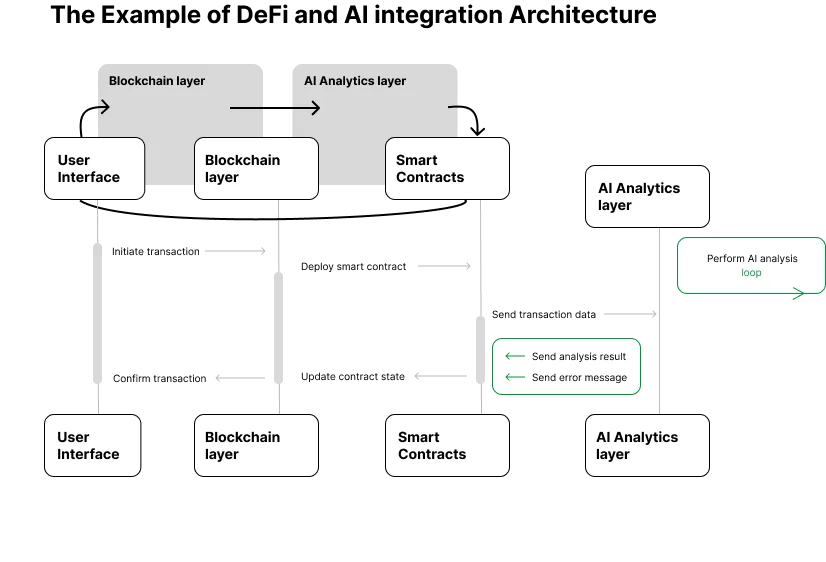Table of content
The emergence of Web3 and AI technologies is inevitable. Some researchers, in particular, are making significant breakthroughs. Professor Yonggang Wen of Nanyang Technological University (NTU) is one of them. In his talk “When AI Meets Web3 (Blockchain)” at SmartCon 2024, he emphasized this idea that the combination of AI and Web3 may lead to the development of a single theory for today’s revolutionary technologies.
Nevertheless, businesses need practical solutions. While Web3 and AI adoption continue to grow, founders and investors seek scalable trust, sustainable value creation, and game-changing business models. This material reveals how AI reinforces Web3 benefits like scalability, transparency, and security, leading to smarter automation, personalized user experiences, and more resilient decentralized networks.
Want to know more about how Web3 and AI synergy enhances businesses from an expert Web3 dApp development company? Start reading now.
Even apart from AI-driven integrations, Web3 is evolving at a high pace. However, it was mostly concerned with decentralizing blockchain for users to own digital assets, take part in peer-to-peer networks, and engage in decentralized financing (DeFi).
The reality is less flashy. The usability, scalability, and meaningful user interaction were issues for early Web3 platforms. The Web3 potential was restricted to specialized communities and experiments since it lacked intelligent automation and personalization. As a result, it was far from mass commercial acceptance.
How AI in Web3 Reinvents Businesses
Modern users crave seamless, intelligent, and scalable experiences that cannot be provided by Web3 alone. So, enhanced by AI, Web3 receives decentralized ecosystems automation, personalization, and adaptive decision-making. Let’s break down how businesses can harness the surge of AI adoption:
Track New Tech
ChatGPT’s revolutionary features caught practically everyone off guard when they first launched. No one expected this surge of features, tech, and in-depth adoption that AI-powered features showed in the past two years. However, it’s not completely unpredictable. Disruptive innovations often show an S-curve. When significant turning points are reached, they might quicken and bring about significant advancements and market acceptance.
The same is with the AI in Web3. Businesses should never undervalue the rate of change. Companies must be on the lookout for new technologies and always scan the market for new opportunities, such as:
- generative content creation in the metaverse,
- on-chain data labeling and training like tokenizing the data labeling process,
- AI-enhanced DAOs for governance optimization, automated decision suggestions, or fraud detection, etc.,
- AI audit and security agents for smart contracts and other.
AI-Plus Business Plan
Businesses in a variety of industries and regions are actively preparing for GenAI. Many are beginning by creating proofs of concept and experimenting with use cases. However, the first stage in future-back strategic planning is to establish a vision for how AI could disrupt your business model and revolutionize your sector to go from tactical and reactive to strategic and proactive.
Consider AI in conjunction with other technologies that may arise in the future, perhaps even before they are expected to, as you construct your vision and plan.
Examine Intersections
We are convinced that the combination of Web3 and AI gives better results than apart. The potential advantages of business activities and technologies together offer your company new opportunities to thrive.
With AI as a tool, Web3 specialists automate trust. Their proactive, logic-first approach helps teach risk teams to use AI to forecast and mitigate risk rather than merely reporting it. Moreover, similar AI-driven insights on team decisions could be useful for internal governance.
Furthermore, AI-powered features go beyond business structure. B2C operations’ future lies in decentralized identities and AI chat, too. This concept inspires your customer operations and lowers expenses and friction. Web3’s transparency compels accountability.
Enterprises Transform into Crowds
We are all used to the idea that centralized AI models gather insights and value from data and people. But what if there is more? Web3 can grant AI capabilities for everyone, not just large companies. Everybody with their knowledge, interests, and experiences as creators will train AI models.
A fitness coach may create a personalized AI that provides tailored exercise plans, or a gardener may offer plant maintenance advice. This shift lets people use AI not just as consumers but also as independent creators and innovators.
Consumers Turn Actors
Today’s platforms are designed for large-scale consumption. Creators will need their own platforms based on Web 3 architecture through social token exchanges and personal AIs. As new collaborative networks emerge, the connection between value production and consumption will change. Now, power belongs to people, not platforms. The people who are not simply spectators but co-authors and co-actors.
Given these drastic changes in the way Web3 and AI intertwine, let’s investigate the main domains that AI influences the most.
Key Areas Where AI Influences Web3
In a nutshell, AI makes Web3 more decentralized, secure, and user-centered. Therefore, by embedding AI in Web3, we can transform digital experiences into something bigger, something increasingly intelligent, efficient, and personalized. Here are some examples:
- Data Analysis: AI unlocks new patterns, informs development, optimizes solutions, and improves Web3 security. We will understand more about how things work and will receive tools to manage processes.
- Smart Contracts: AI improves smart contracts with sophisticated data-driven decision-making. In particular, new triggers and scoring might be implemented, increasing productivity and flexibility.
- Personalization: For improved user engagement in Web3, AI-driven customization personalized interactions, recommendations, and content.
- Web 3 Architecture and Apps: By connecting digital services and human language, natural language processing (NLP) enhances user interaction and content creation.
- Decentralized Autonomous Organizations (DAOs): DAOs significantly benefit from AI because it streamlines resource distribution, ensures transparency, and automates decision-making.
- Decentralized AI: Data privacy, model training, and resource allocation are all improved by combining AI with decentralized technologies like blockchain.
- Security and Privacy: In Web3 ecosystems, AI protects data privacy through encryption and anonymization, enhances authentication, and identifies dangers. Partially, we’ve described the process in the guide on how to adopt Web3 payments for your business.
While AI can transform Web3, it introduces risks such as data privacy concerns and the potential for AI-driven cyber threats, which require careful management to ensure security and trust.
Web3 AI Challenges
Although AI-driven technologies have many advantages, they also pose new issues that businesses must tackle.
Collapse of Trust
The researchers note that many people foresee AI-driven negative effects on news, highlighting the possible uncanny valley effect in human-agent interaction. Thus, AI-generated content could undermine public trust because people may begin to question its authenticity. A countermeasure could be watermarking or tagging information produced by AI to warn users.
Automated Cyber Threats
Global cybersecurity is facing increasing threats from AI-driven cyberattacks. Robust cybersecurity practices are a must-have to mitigate these risks. Plus, AI-powered security systems are best at battling AI-powered threats.
They are much more efficient in analyzing code patterns to identify vulnerabilities and reduce the risk of exploitation than traditional techniques. Additionally, adding blockchain to them ultimately enhances the software development security.
Legislative Loopholes
Since AI is an innovation, legislation and state regulation lag in addressing its challenges. Thus, legal loopholes can be exploited with AI-generated content. For instance, deep fake videos manipulate public awareness, while automated contract generation is also threatened with compromised agreements.
To rectify the situation, lawmakers and regulators must keep up with developments in AI technology. If they fail to do it alone, then multidisciplinary cooperation between legal professionals, AI researchers, and ethicists might help, enabling the ethical use of AI.
Despite these challenges, the ongoing evolution of AI and Web3 continues to unlock new possibilities, reshaping the digital landscape in profound and innovative ways.
How Will AI and Web3 Evolve with Time? What to Expect
These days, we see that AI and Web3 are more than just a buzz. Separately, they reshape the user experience, but together, they are much more potent. Web3 deployment has the potential to democratize AI technology access and utilization, and in its turn, AI boosts Web3 benefits at scale. And AI, in its turn, boosts Web3 benefits at scale.
The decentralized Web3 architecture, along with the automation and personalization potential of AI, will:
- Give users complete control over their data privacy and autonomy,
- Encourage custom online experiences,
- Encourage moral digital platforms that give communities and creators more power,
- Encourage the development of innovative business models, etc.
Furthermore, AI and Web3 will certainly pave the way for a more user-centric Internet of Things. Additionally, Web3 will go beyond personalization by providing full data autonomy, an individualized internet experience, and ethical internet platforms for people.
Together, AI-augmented Web3 architectures will create a more intelligent, equitable, and trusted digital future, accelerating adoption by businesses and users worldwide.
Key Takeaways
Web3’s promise of scalable trust is unlocked by AI, as it turns isolated blockchain trials into dynamic, user-first ecosystems. AI-augmented Web3 platforms speed up business adoption and open the door to a decentralized, collaborative Internet. There, people and communities directly own and govern their data and digital assets, benefiting each other.
Riding the surge of innovation, Devox Software supports new environments and architectures, changing how companies innovate and how people use digital services globally. We create, modernize, and innovate apps and systems to bring value to businesses and users. Deliver your needs and wishes to our expert AI and Web3 developers, and they will find the solution.















